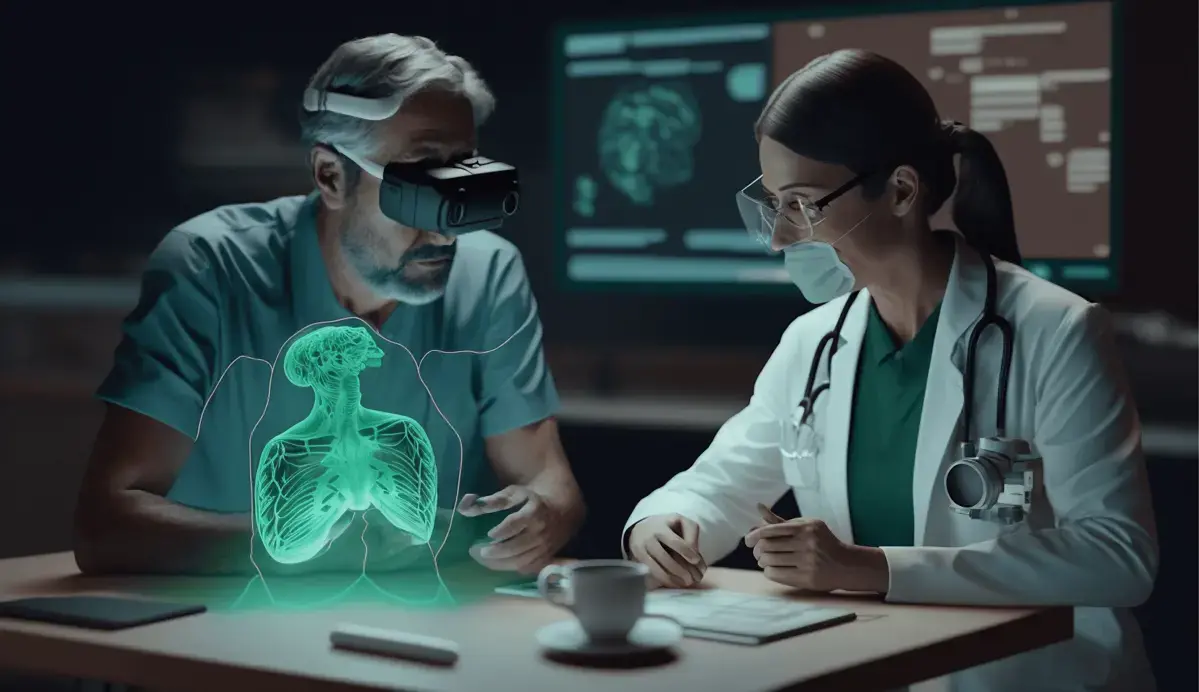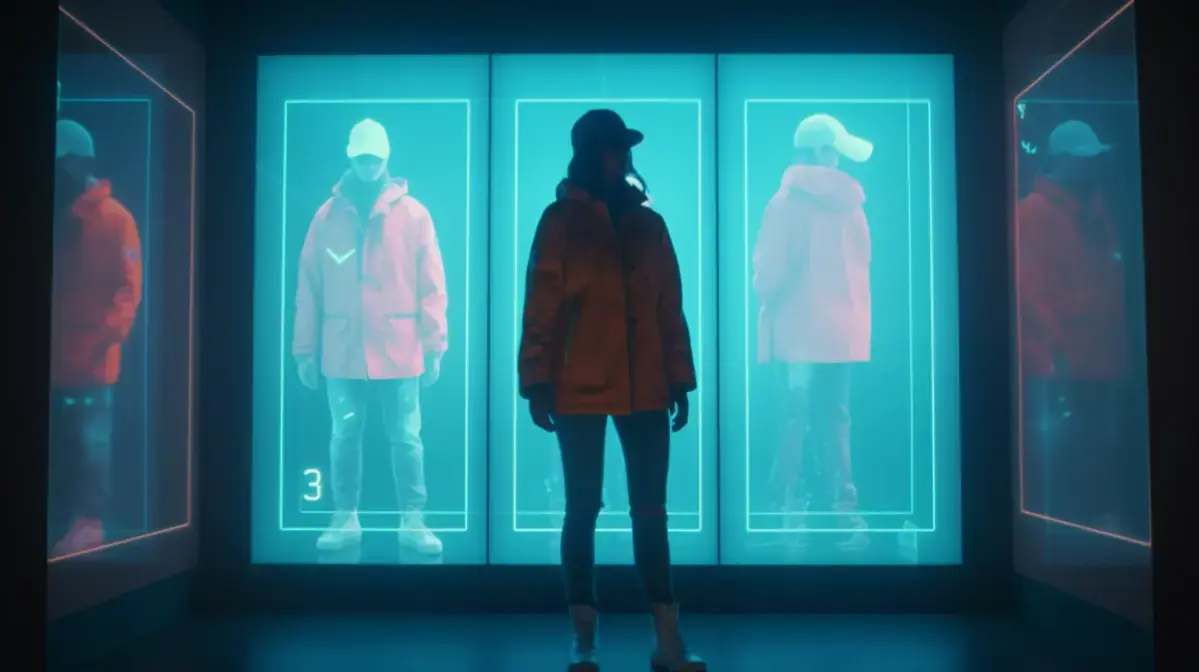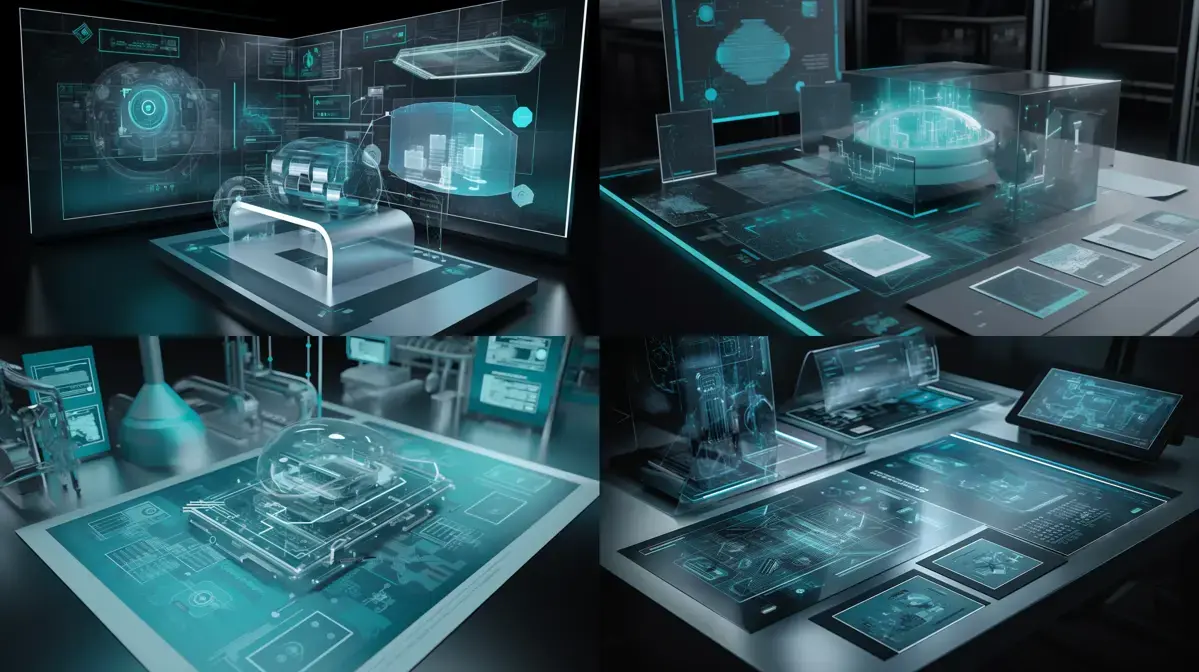Augmented reality (AR) technology is revolutionizing the way businesses interact with their customers. One performant feature of AR that improves customer experience is its ability to provide real-time product information and visualization. By simply pointing a smartphone or tablet at a product, customers can view detailed specifications, see how it would look in different colors or sizes, and even visualize it in their own environment using AR overlays.
This not only enhances the shopping experience but also enables customers to make more informed purchasing decisions. For example, furniture retailers can use AR to allow customers to virtually place items inside their homes before making a purchase.
Furthermore, AR provides an interactive platform for brands to engage with consumers in new ways. Retailers can create compelling experiences through gamification or immersive storytelling using augmented reality technology which leads them towards brand loyalty and eventually higher sales conversion rates.
In conclusion businesses should leverage on this cutting-edge technology of Augmented Reality for improving customer experiences leading upsurge growth among target audience base while contributing tremendously towards better client retention rate as well as maintaining competitive edge ahead of rivals. Learn more about Augmented Reality by reading our article here: Augmented Reality.
Table Of Contents
- Key Points
- Introduction: What is Augmented Reality and How Does it Work?
- The Benefits of Using Augmented Reality for Customer Experience
- Enhancing Product Visualization with Augmented Reality
- Interesting Facts
- Personalizing the Shopping Experience with Augmented Reality
- Engaging Customers through Gamification with Augmented Reality
- Improving Customer Service with Augmented Reality
- FAQs
- Reducing Returns and Increasing Sales Conversion Rates with AR
- Case Studies: Brands That Have Successfully Implemented AR for Customer Experience
- Future of augmented reality in customer experience
- Key Takeaways

Key Points
- Augmented reality enhances customer engagement and interaction, making it a valuable tool for businesses.
- It creates an immersive experience that allows customers to visualize products in their real-world environment before purchasing them.
- Augmented reality provides a personalized shopping experience by offering customized recommendations based on the user’s preferences and browsing history.
- By using augmented reality, businesses can create memorable experiences that leave lasting impressions on their customers, leading to increased loyalty and retention rates.
Introduction: What is Augmented Reality and How Does it Work?
Augmented Reality (AR) is a technology that enhances the real world with computer-generated visuals, sounds, and other sensory inputs. It’s like a digital layer over the physical world we see around us every day. AR has come a long way since its inception in science fiction movies to becoming an everyday reality for millions of people worldwide.
To understand how AR works, imagine seeing your surroundings through an electronic screen or lens. The camera on your device captures images of what you’re looking at – be it a street corner or an object – which are then fed into powerful software that overlays virtual elements onto these live views in real-time.
For instance, when using Snapchat filters where dog ears appear on people’s faces while taking selfies – this is augmented reality technology at work. Similarly, Pokemon Go used AR to place digital creatures within our environment so players could catch them by pointing their phone cameras towards them.
AR can be experienced through smartphones and tablets as well as standalone devices like headsets or smart glasses such as Hololens by Microsoft®, Magic Leap One Creator Edition® etcetera (SEO Keyword). These gadgets have sensors capable of detecting motion plus orientation changes while users move around during their escapades.
At first glance navigating Augmented Reality may seem intimidating but once one gets started there’s no stopping exploring new worlds enhanced with rich textures overlaid upon familiar terrains. The possibilities are endless and if utilized properly can revolutionize gaming experiences, customer engagement platforms, military operations among others.
The Benefits of Using Augmented Reality for Customer Experience
Augmented Reality (AR) is a technology that has been around for several years. It allows people to enhance their real-world experience by overlaying digital content on top of it. AR can be used in various fields, including education, entertainment, and healthcare.
The concept of AR may sound complicated at first glance but understanding how it works is quite simple. The technology uses cameras and sensors to detect the user’s surroundings and then places virtual objects or information onto the screen in real-time.
For example, imagine walking down a street using your smartphone camera; through AR technology – instead of seeing just buildings – you could see useful information pop up like nearby shops or restaurants with reviews from other users appearing over them as you walk.
AR can also work with wearable devices such as smart glasses. These devices allow users to immerse themselves fully into an augmented environment while still having control over their physical surroundings – similar to wearing goggles put on during swimming.
Overall Augmented Reality offers endless possibilities for enhancing our daily lives while boosting engagement levels regardless if we’re working remotely or attending conferences across countries – truly moving us one step closer into utilizing Sci-Fi tech in everyday life.
Enhancing Product Visualization with Augmented Reality
Augmented reality (AR) is a technology that overlays digital information onto the real world. It’s like having an extra layer of reality on top of what you can see. Imagine standing in front of a famous landmark and being able to view historical photos, videos, and information about it simply by looking through your phone or AR glasses.
The way AR works is through the use of cameras, sensors, and GPS technology on devices such as smartphones or wearable tech like smart glasses. These tools capture real-time data from the world around us and convert it into virtual experiences that we can interact with.
One example where this comes into play is in gaming experiences such as Pokemon Go. The game uses your smartphone camera to display characters superimposed onto real-world locations allowing players to ‘catch’ them just by walking around their everyday environment – providing both entertainment value as well enhancing physical activity engagement .
But augmented reality has many other applications beyond gaming- from manufacturing processes on assembly lines which improve safety for workers ,to healthcare professionals using surgical simulations for training . The possibilities are endless.
So why not give augmented reality a try? Who knows what kind amazing new experience one might discover…and unlock opportunities unseen before.
Interesting Facts
- Augmented reality has been around for over 50 years, but it’s only in recent years that the technology has become advanced and accessible enough to be used in a customer experience setting.
- The global augmented reality market is projected to reach $72.7 billion by 2024, with retail being one of the industries driving its growth.
- A study found that customers who experienced products through augmented reality were almost twice as likely to make a purchase than those who did not use AR.
- In addition to retail, other industries such as tourism and education are also utilizing augmented reality technology for enhanced customer experiences.
- The first known commercial application of Augmented Reality was actually made on television screens during broadcasts of football games. It allowed viewers at home see an on-screen yellow “first down” line so they could better understand where the team had reach before getting four more chances (downs) with which advance further up field or score points.

Personalizing the Shopping Experience with Augmented Reality
Augmented Reality (AR) is a technology that allows users to interact with the real world in new and exciting ways. AR overlays digital content onto the user’s view of reality, enhancing their perception of their surroundings and enabling them to interact with virtual components as if they were part of the physical environment. This technology has revolutionized entire industries, from gaming to retail, by creating immersive experiences that blur the lines between reality and imagination.
At its core, AR works by using cameras or sensors on a device such as a smartphone or headset to capture images/video from your surroundings. The software then processes this information and inserts virtual objects into those images so they appear blended into real life scenes – like little animations embodying depth sensations seamlessly integrated within your actual field-of-view. Whether you’re playing an augmented-reality game like Pokemon Go or trying on clothes using Snapchat filters at home before purchase – it all feels just like magic.
AR applications have exploded in popularity over recent years thanks not only due its technical capabilities but also because overall increased awareness about environmental issues which brings attention towards implementing alternative methods for consuming goods & services; rather than needing physically existent manifestations everywhere. For example; retailers use AR to improve customer engagement through product interactions where customers can preview items while simultaneously seeing how those products look when incorporated into multiple environments without actually having them there physically (which reduces harm done).
The possibilities for application are virtually limitless, for both personal enthusiasts seeking entertainment value out of the box capabilities offered through novel sensing mechanisms. These are combined with advanced algorithms implementing spatiotemporal registration/alignment techniques, paired alongside emerging microservices toolkits. There are also commercially appealing opportunities catering towards mass-market consumption oriented goals too. Overall, Augmented Reality is definitely worth exploring further given current advancements made thus far.
Engaging Customers through Gamification with Augmented Reality
Augmented Reality (AR) is a fascinating technology that has been capturing people’s imaginations for years. It combines the digital world with the real world, creating an interactive and immersive experience that can be both informative and entertaining. Simply put, AR overlays computer-generated information onto the user’s physical surroundings through a device such as a smartphone or tablet.
The beauty of AR lies in its ability to enhance reality without replacing it entirely. Imagine walking down a street in your city, not only seeing buildings but also being able to access historical information about them by pointing your phone camera at them. Or picture yourself sitting on your couch at home and suddenly being transported into an interactive game where virtual creatures are running around you.
As someone who has been working with AR for many years now, there is no denying that this technology constantly amazes me. I have seen firsthand how seamlessly it can integrate into our everyday lives – from helping doctors visualize surgeries better to revolutionizing shopping experiences by allowing customers to try out products before purchasing.
In essence, Augmented Reality allows us to see things differently – quite literally. It opens up new worlds of possibility while still keeping us grounded in reality – something truly remarkable indeed.
Improving Customer Service with Augmented Reality
Augmented Reality (AR) is a technology that has been around for quite some time, but only recently has it become more accessible and mainstream. AR involves superimposing computer-generated images onto the real world, creating an interactive and immersive experience that can be utilized in a variety of ways. The possibilities are endless – from gaming to education to tourism, AR is being adopted by industries far and wide.
But how does it work? AR systems use cameras or sensors to detect objects or patterns in the physical environment. These objects then trigger the display of virtual content on top of them through smartphones, tablets or dedicated headsets such as HoloLens 2 by Microsoft which allows users access information without needing a screen nor becoming completely absorbed within their device.
One example where AR is being used effectively is in retail marketing. Imagine walking into your favorite department store with your smartphone camera ready for anything that catches your eye; when you point your phone at any product on display like Nike trainers with their unique bar codes embedded within them You see augmented reality adverts showcasing its features. This could include videos showing people wearing the shoes while exercising with useful tips about fitment all visible before purchasing.
Overall Augmented reality continues disrupting multiple sectors – from improving medical procedures via digital overlays during surgeries, precision during complex engineering processes and even enhancing art exhibitions. AR gives us new ways we can learn explore & discover things we never thought possible.
FAQs
1. What is augmented reality?
Augmented Reality (AR) is a technology that uses computer-generated data to enhance the real-world environment by overlaying digital information onto physical objects or spaces.
2. How can AR improve customer experience?
AR can provide customers with interactive and immersive experiences, allowing them to see products in a more realistic way, try on virtual clothing or makeup before purchasing, and learn about products through engaging digital content.
3. What industries are using AR for customer experience?
Many industries are implementing AR for improved customer experiences including retail, fashion, beauty, automotive industry and even museums
4. Do I need special equipment to use AR in my business?
Depending on the type of implementation you choose such as mobile app-based implementation or smart glasses hardware based system you might require specific hardware however most of the time smartphone devices that support Augmented Reality implementations will suffice .

Reducing Returns and Increasing Sales Conversion Rates with AR
Augmented Reality (AR) is a technology that blurs the line between the physical and digital worlds. It enhances one’s perception of reality by overlaying computer-generated images onto their real-world environment. From gaming to education, AR has become an increasingly popular tool in various industries.
AR works by using cameras, sensors and other advanced technologies to track user movements and create immersive experiences on mobile devices or specialized headsets. It uses markers or geolocation data to determine where virtual objects should appear in relation to the real world.
This innovative technology allows users not only to see but also interact with digital content within their surroundings as if it were actually there in front of them. Imagine walking around your home with furniture you haven’t purchased yet appearing before your eyes – a simulation that can help you better visualise how different pieces would fit into space just from looking through your phone display screen.
As an expert in AR, I have seen firsthand how this technology has revolutionized numerous industries over recent years including retail, automotive and healthcare- providing countless opportunities for businesses wanting greater engagement with customers while boosting sales or productivity among teams.
Case Studies: Brands That Have Successfully Implemented AR for Customer Experience
Augmented Reality is one of the most exciting technologies around today. It allows users to interact with digital elements in a way that was previously impossible, giving an immersive, unforgettable experience unlike any other. If you’re not familiar with AR yet, don’t worry: it’s easy to understand once you get the hang of it.
Put simply, Augmented Reality overlays digital images onto the real world through your smartphone camera or special headsets. Imagine walking down a street and seeing all sorts of incredible objects popping up on screen as if they were really there – from virtual pets to 3D models and beyond. This technology has limitless potential for gaming, education and entertainment alike.
One great example comes from Pokémon Go; a mobile game which lets players hunt for cute creatures using their phone’s GPS system while also integrating AR features that make these critters appear as though they’re actually in front of them. The result? A global phenomenon that took over smartphones across millions worldwide.
AR isn’t just something cool for gamers either; professionals in fields such as architecture can use this technology to display designs over existing structures so clients can see what proposed renovations will look like before any physical work is done. That means faster decision-making times without costly errors.
Future of augmented reality in customer experience
Augmented Reality (AR) is an innovative technology that allows users to experience the digital world in a real-world setting. It overlays computer-generated content onto the user’s view of the physical environment, creating a mixed reality experience. AR has revolutionized various industries, including gaming, entertainment, education and healthcare.
The idea behind AR is to enhance one’s perception of their physical surroundings by adding virtual objects or information in real-time; this could be anything from pointing your phone at an object and seeing additional information about it displayed on your screen to trying out clothes virtually before you buy them online.
One way AR works is through marker-based tracking where a camera detects pre-defined markers such as QR codes or images which triggers the display of 3D graphics when viewed through an app or device. Another method uses GPS location data for overlaying digital content based on one’s current location while another technique tracks facial expressions and gestures from cameras mounted within head-mounted displays like Microsoft Hololens – allowing users greater freedom with how they interact with virtual objects around them.
AR provides endless possibilities for creativity as its potential expands across numerous industries; just imagine attending concerts without leaving home using VR headphones. Companies have already begun investing heavily into developing these technologies so they can continue riding this wave making sure that it never crashes upon new innovations coming down fast following close behind – all waiting eagerly at our fingertips.
Conclusion
Augmented reality is here to stay and has proven to be an amazing tool for improving customer experience. With AR technology, businesses can engage with their customers in a more interactive and immersive way, enriching the user’s shopping or viewing experience. Customers are able to visualize products before making purchase decisions as well as receive additional information about products from anywhere they are.
In today’s digital world where online shopping is on the rise, it’s important that retailers find new ways of engaging with potential customers effectively; augmented reality presents just such an opportunity. It offers consumers a new level of engagement while helping companies improve their bottom line by providing exceptional experiences that increase brand loyalty.
To remain competitive in this ever-changing marketplace, it’s imperative for businesses of all sizes across various industries to embrace technologies like AR which provide a unique platform for enhancing customer relationships through personalized and memorable experiences – This ultimately leads to increased sales growth over time.
Key Takeaways
- Augmented Reality (AR) has the potential to enhance customer experience across various industries.
- AR can provide interactive and immersive experiences, leading to increased engagement and satisfaction.
- The use of AR in retail can improve the online shopping experience by allowing customers to visualize products in their real-life environment before purchasing them.
- In healthcare, AR can assist doctors with procedures and enable patients to understand their diagnoses better.






































